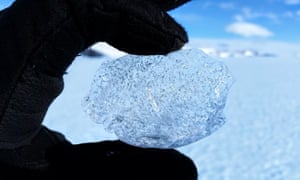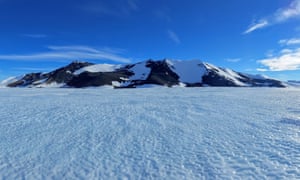Cause of rise was ocean warming of less than 2C, which has major implications for future, researchers warn
Mass melting of the West Antarctic ice sheet, driven by warmer ocean
temperatures, was a major cause of extreme sea level rise more than
100,000 years ago, according to new research.
A research team, led by scientists at the University of New South Wales, examined the cause of high sea levels during a period known as the last interglacial, which occurred 129,000-116,000 years ago.
Their study finds that melting of the West Antarctic ice sheet caused a sea-level rise of more than three metres and it took less than 2C of ocean warming for that to occur.
The authors say their findings could have “major implications” for the future given the ocean warming and ice melt currently occurring in Antarctica.
The study’s lead author Chris Turney is a climate change and earth scientist at UNSW.A research team, led by scientists at the University of New South Wales, examined the cause of high sea levels during a period known as the last interglacial, which occurred 129,000-116,000 years ago.
Their study finds that melting of the West Antarctic ice sheet caused a sea-level rise of more than three metres and it took less than 2C of ocean warming for that to occur.
The authors say their findings could have “major implications” for the future given the ocean warming and ice melt currently occurring in Antarctica.
He said the West Antarctic was particularly vulnerable to ocean warming because it sits mostly on the sea bed, rather than on land.
“This has been a big concern and is what the concern is in the present day,” Turney said.
“So the question is how much could fall into the ocean and this is where the last interglacial [period] is so important.”
The paper says ocean temperatures during the last interglacial were likely up to 2C warmer than they are today and global sea levels were 6-9 metres higher.
To trace Antarctica’s potential contribution to this sea-level rise, the scientists travelled to West Antarctica to the Patriot Hills Blue Ice Area, which is on the periphery of the West Antarctic ice sheet.
Blue ice areas are created by katabatic winds. When these winds blow over mountains, they remove snow and ice, allowing ancient ice to come to the surface.
A lot of Antarctic research involves deep ice core drilling to study years of climate history.
In this study, the researchers used what they called “horizontal ice core” analysis, which involved simply walking across the valley towards the mountain.
“As you walk towards the mountain, you walk over increasingly older ice,” Turney said.
They used some shallow drilling to take ice samples from the surface. Through isotope measurements, they found a gap in the ice sheet record immediately prior to the last interglacial.

Turney said this gap coincided with an extreme rise in sea level and suggested a period in which there was no ice accumulating in that valley.
“It means that a large part of the west Antarctic almost certainly disappeared in the last interglacial. It melted. It flowed rapidly into the ocean,” he said.
He said the research also suggested this mass melting happened quite early during the ocean warming “somewhere between zero and 2C”.
Countries have signed on to the Paris agreement which aims to keep global heating below 2C.
Turney said the current summer in Australia alone had shown the dangers of a warming world just at 1C.
He said the team’s research could be used to focus on which sections of West Antarctica are most vulnerable to the current climate crisis.
“What these results suggest, or show, is that when people talk about a 2C warmer world as a good thing, actually what it shows is we don’t want to get close to 2C,” he said.

No comments:
Post a Comment